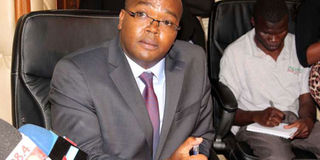Health scandal exposes the cruel face of graft cartels

Nicholas Muraguri, the Principal Secretary for the Ministry of Health, at a press conference at Afya House in Nairobi on October 28, 2016. PHOTO | DENNIS ONSONGO | NATION MEDIA GROUP
What you need to know:
- You know Kenya has gone to the dogs when they steal from Kenyatta National Hospital, the country’s largest referral health facility mostly in the news for its stone-age problems like the single broken down cancer machine.
- The health advocacy group KANCO says there is a huge financing gap for disease control and treatment programmes, with donor support also shrinking.
- The Treasury’s budget allocation of six per cent to the Ministry of Health is a drop in the ocean.
The Ministry of Health scandal exposed by the Business Daily last week is not a normal official corruption story.
And it is not because of the dizzying amounts of taxpayers’ money – up to Sh5 billion – suspected to have been stolen by the Afya House gang. Or the Health Principal Secretary’s sick sense of his powers in that public office he holds.
This is official corruption at its most cruel and unbelievable. You know Kenya has gone to the dogs when they steal from Kenyatta National Hospital, the country’s largest referral health facility mostly in the news for its stone-age problems like the single broken down cancer machine.
You know it is getting beyond redemption when they raid the maternity ward and steal money meant to save the lives of poor mothers and their newborns.
The corrupt cartels can’t sink any lower when their target is the country’s public health system – which has long been on financial life support, its heart kept barely beating by the mercy of foreign donors.
The Treasury’s budget allocation of six per cent to the Ministry of Health is a drop in the ocean compared to the 15 per cent target the country set itself with the signing of the Abuja Declaration in 2001.
As you would expect, a big chunk of the ministry’s meagre allocation is spent on paying salaries and allowances.
The health advocacy group KANCO says there is a huge financing gap for disease control and treatment programmes, with donor support also shrinking.
AID CUTS
It gets more complicated if you consider the current vibes from donors suggesting significant aid cuts are in the offing after Kenya recently upgraded its economic status to lower middle-income country.
The country will, for instance, be required to increase its contribution to the Global Fund, which heavily supports the fight against the three major killers – malaria, HIV/Aids and TB.
Kenya may also have to pick much more of the bill for its national immunisation programmes with the Gobal Alliance for Vaccines, which helps low-and-lower-middle-income countries procure low-cost vaccines, likely to review its rules of engagement.
Indeed Kenya’s rebasing of its economy is turning out to be somewhat bittersweet; a couple of countries have put bilateral aid on the chopping board as well.
The Dutch have sent the clearest signal so far, saying their future support will focus on trade and investment.
Priti Patel, the UK International Co-operation and Development Minister who was in Nairobi last week, spoke along more or less the same lines regarding her country’s post-Brexit view of foreign aid.
The long and short of it is that Kenya will henceforth have to mobilise domestic resources to fund its vital social programmes like health.
That journey has to start with safeguarding the taxpayers’ money, however inadequate, that is being given to Afya House – not letting the graft cartels loot it.





